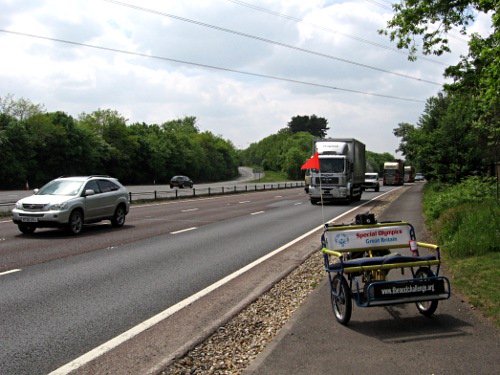
When I started planning my trip a year or so back, I struggled to find any information about cycling rickshaws long distance. Almost as if it wasn’t a common thing to do. So, here are some tips if you fancy having a go (which I would highly recommend):
–
1. Use the Rickshaw Forum
–
2. Don’t worry any more or less about weight when packing than you would for a normal bike trip
The truth is that an extra pair of socks and one more litre of water won’t feel like as big an impact on you as it would your lighter counterparts but don’t fall foul of “Oh, it’s so heavy already this won’t matter…”. Stick with the same prudence you’d use to pack for any other bike trip. But…
–
3. Make use of the storage space
Size and weight may be your enemies in many instances but do your best to make friends with them too. Loaves of bread and packets of vegetables needn’t be crushed at the top of panniers, and you might find, as I did, room for a wind-up radio and space to store a handy white board.
–
4. Think outside the box to make use of your bike
In addition to the above, can you use your bike for shelter or anything else besides transport? I tied my tarp (like a tent) off of mine and used the seat cushion as a wonderfully comfortable sleeping mat.
–
5. Be courteous to other road users
You are big and you are slow. You will inevitably take up people’s time so pull over to let them pass when you need to and always give a wave and a smile when you can’t. It’ll help avoid any rising road rage and save your vital energy for those hills.
–
6. Consider your width
There will be times when you’ll get to the end of a cycle lane and hit a gate that you can’t get round or bollards you can’t fit through. Maybe you’ll be able to unpack and lift the bike over. Maybe you won’t. There’s no way to foresee these occurrences so just prepare yourself mentally for them and try not to curse too loudly.
–
7. You can get up hills just as well as anyone else
My primary fear upon embarkation was that I would hit hills that I physically couldn’t cycle up. This never happened and I almost never used my lowest gear. Many times I saw people shoot past me on unburdened bikes only to get off and push when the incline picked up whilst I kept on pedalling. No doubt the threshold of limitation is lower for rickshaws but I managed at least 14% gradients and I am not Chris Hoy. Drop your gears, not your head.
–
8. You will be slower than a normal bike
Once you get your head around this, it’s just like any other trip. You’ll soon work out what your average speed is (mine was about 8.5mph) and you’ll probably know that there’s not a huge amount you can do to change that significantly so then your progress is simply down to how many hours for which you want to cycle.
–
9. The ups and downs of cycle routes versus roads are just exaggerated
Sustrans cycle routes take you away from traffic, remove the need for navigation (when they’re good!) and send you through some great scenery. They also tend to be longer than the road-based alternatives and take you up lots of extra hills. The pros and cons of this are no different from normal except that your speed and weight make those hills extra hard work, whilst your speed and width can make busy roads additionally hassle-filled. No great difference, no magic solution, they both work so just go with what you feel.
What do you think? Please do add your thoughts below…